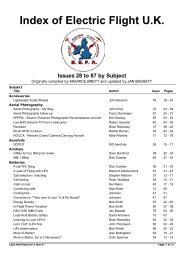electric flight uk - British Electric Flight Association - Jan Bassett's
electric flight uk - British Electric Flight Association - Jan Bassett's
electric flight uk - British Electric Flight Association - Jan Bassett's
You also want an ePaper? Increase the reach of your titles
YUMPU automatically turns print PDFs into web optimized ePapers that Google loves.
uy a PC board with assembled FETs, say for a 2S or a 3S or a 4S (or<br />
whatever the limiting series charging is today) and plug/unplug this to/<br />
from the factory-installed battery flying leads. Or, how do I specify and<br />
where do I buy such FETs, to make my own balancer?<br />
Finally, how can any model shop claim to sell a “balancing charger” to plug<br />
into a battery? I cannot visualise any such thing. In spite of you saying there<br />
is no need for a soldering iron I remain certain that connection to each cell is<br />
essential and if not factory supplied we must do it ourselves. Yes, if my Method<br />
2 works you would be able just to connect up a FET-fitted battery to a suitable<br />
charger - but such a charger would simply have a limiting capability not any<br />
balancing capability and should not be so described.<br />
But again, if I’ve got it wrong I would be delighted to be told.<br />
OK, a lot to cover, so here goes.<br />
In my last response I did simplify things in an attempt to make it easier to<br />
understand the principle. I also erred slightly, what I should have said is that<br />
each balancer circuit contains a FET. Peter is correct that FETs have 3 leads<br />
as identified. However, FETs are available in a number of different varieties<br />
with very different characteristics. The majority of FETs available do not<br />
conduct when the Gate voltage = Drain voltage, which means they are “off”<br />
when power is initially applied.<br />
Over the past few years the “on” resistance has reduced markedly, with surface<br />
mount FETs available as low as 6mÙ for a single FET. This ultra low resistance<br />
means very low loses and that these small packages can handle higher currents<br />
than their predecessors. This is one of the main reasons for the reduction in<br />
cost and size of speed controllers as less FETs are required. For brushless<br />
controllers this is a major advantage when 6 banks of FETs are required.<br />
Peter’s Method 1 could be used, but if that was to chosen method it would be<br />
better incorporated in the charger. Provided the voltage across each cell can<br />
be maintained it would work. I consider that this method is unnecessarily<br />
complicated and would not be cost effective.<br />
Method 2 is along the lines used by commercial balancers, although you can<br />
do it as simply as this. I’ll describe how a typical LiPo balancer circuit works<br />
in the following paragraphs and hopefully everything will become clear.<br />
A LiPo balancer typically contains a precision voltage reference, a voltage<br />
comparator, a number of discharge resistors, a pulse-width modulator (PWM),<br />
and a FET. The voltage reference is used by the comparator to produce an<br />
error signal. This error signal controls the PWM, which turns the FET on<br />
and off. As the voltage rises above 4.21v, the PWM starts with short pulses,<br />
which increase in width until, the FET is always on at 4.25v.<br />
Typically they also have a LED on the board, which indicates what the balancer<br />
E.F.-U.K. 21















